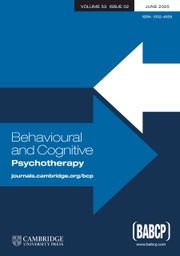Crossref Citations
This article has been cited by the following publications. This list is generated based on data provided by
Crossref.
Short, Megan M.
Mushquash, Aislin R.
and
Sherry, Simon B.
2013.
Perseveration moderates the relationship between perfectionism and binge eating: A multi-method daily diary study.
Eating Behaviors,
Vol. 14,
Issue. 3,
p.
394.
Pender, Sarah
Gilbert, Sam J.
Serpell, Lucy
and
Aguilera, Abelardo I.
2014.
The Neuropsychology of Starvation: Set-Shifting and Central Coherence in a Fasted Nonclinical Sample.
PLoS ONE,
Vol. 9,
Issue. 10,
p.
e110743.
Vall, Eva
and
Wade, Tracey D.
2015.
Trail Making Task Performance in Inpatients with Anorexia Nervosa and Bulimia Nervosa.
European Eating Disorders Review,
Vol. 23,
Issue. 4,
p.
304.
Zegarra-Valdivia, Jonathan Adrián
and
Chino-Vilca, Brenda Nadia
2018.
Social Cognition and Executive Function Impairment in Young Women with Anorexia Nervosa.
Clínica y Salud,
Vol. 29,
Issue. 3,
p.
107.
Morris, Lydia
and
Mansell, Warren
2018.
A systematic review of the relationship between rigidity/flexibility and transdiagnostic cognitive and behavioral processes that maintain psychopathology.
Journal of Experimental Psychopathology,
Vol. 9,
Issue. 3,
p.
204380871877943.
Marzola, Enrica
Fassino, Secondo
Migliaretti, Giuseppe
Abbate-Daga, Giovanni
and
Kaye, Walter H.
2019.
Development and validation of the Premorbid Childhood Traits Questionnaire (PCT-Q) in eating disorders.
Eating and Weight Disorders - Studies on Anorexia, Bulimia and Obesity,
Vol. 24,
Issue. 5,
p.
815.
Dahlenburg, Sophie C.
Gleaves, David H.
and
Hutchinson, Amanda D.
2019.
Anorexia nervosa and perfectionism: A meta‐analysis.
International Journal of Eating Disorders,
Vol. 52,
Issue. 3,
p.
219.
Kannis-Dymand, Lee
Hughes, Emily
Mulgrew, Kate
Carter, Janet D.
and
Love, Steven
2020.
Examining the roles of metacognitive beliefs and maladaptive aspects of perfectionism in depression and anxiety.
Behavioural and Cognitive Psychotherapy,
Vol. 48,
Issue. 4,
p.
442.
Tng, Germaine Y. Q.
and
Yang, Hwajin
2021.
Interactional Effects of Multidimensional Perfectionism and Cognitive Emotion Regulation Strategies on Eating Disorder Symptoms in Female College Students.
Brain Sciences,
Vol. 11,
Issue. 11,
p.
1374.
Awad, Emmanuelle
Obeid, Sahar
Sacre, Hala
Salameh, Pascale
Strahler, Jana
and
Hallit, Souheil
2022.
Association between impulsivity and orthorexia nervosa: any moderating role of maladaptive personality traits?.
Eating and Weight Disorders - Studies on Anorexia, Bulimia and Obesity,
Vol. 27,
Issue. 2,
p.
483.
Hernández-Muñoz, Sandra
and
Camarena, Beatriz
2022.
Aportación de los estudios de la personalidad en la definición de subtipos de anorexia nervosa y bulimia nervosa.
Revista Colombiana de Psiquiatría,
Laufer, Sofia
Herman, Estee
Serfaty, David
Latzer, Yael
Ashkenazi, Rachel
Attias, Orna
Oren, Sinai
Shimomi, Meirav
Uziel, Moria
Enoch-Levy, Adi
Witztum, Eliezer
and
Stein, Daniel
2023.
Case report: Anorexia nervosa and unspecified restricting-type eating disorder in Jewish ultra-orthodox religious males, leading to severe physical and psychological morbidity.
Frontiers in Psychiatry,
Vol. 14,
Issue. ,
Styk, Wojciech
Zmorzynski, Szymon
and
Samardakiewicz, Marzena
2023.
Persistence Is Multi-Trait: Persistence Scale Development and Persistence Perseveration and Perfectionism Questionnaire into Polish Translation.
Brain Sciences,
Vol. 13,
Issue. 6,
p.
864.
Miranda-Olivos, Romina
Agüera, Zaida
Granero, Roser
Jiménez-Murcia, Susana
Puig-Llobet, Montserrat
Lluch-Canut, Maria Teresa
Gearhardt, Ashley N.
and
Fernández-Aranda, Fernando
2023.
The Role of Food Addiction and Lifetime Substance Use on Eating Disorder Treatment Outcomes.
Nutrients,
Vol. 15,
Issue. 13,
p.
2919.





Comments
No Comments have been published for this article.